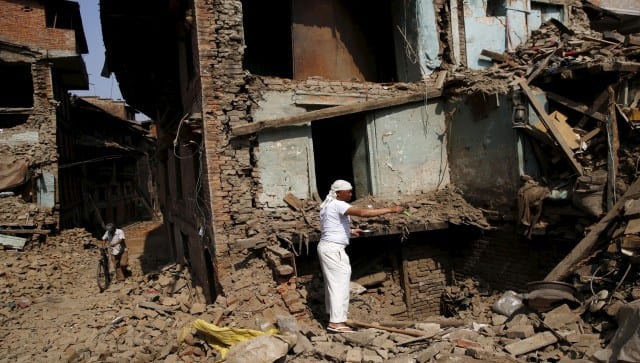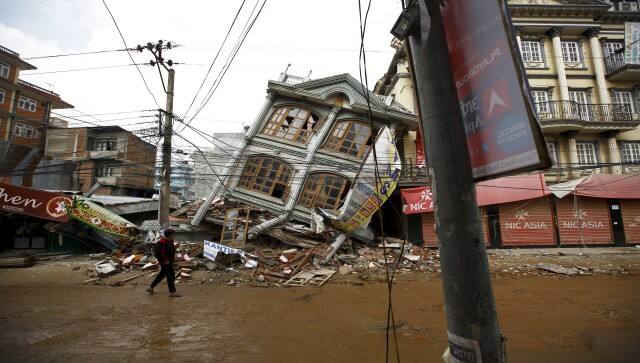People in Nepal were jolted awake on Friday night after a magnitude-6.4 earthquake struck a remote region. Late night, residents were scouring the debris of collapsed homes and buildings for survivors by digging through the rubble. According to an Associated Press report, at least 128 people were killed, and hundreds more have been injured. Authorities said the death toll was expected to rise, noting that communications were cut off in many places. The strong quake is the latest temblor to strike the neighbouring country – on 22 October this year, a devastating earthquake of 5.2 magnitude flattened Nepal’s capital Kathmandu and damaged 20 houses. We take a closer look at why Nepal is so prone to earthquakes. Strong earthquake jolts Nepal Just before midnight Friday, a strong earthquake of 6.4 magnitude shook northwestern Nepal districts, claiming at least 128 lives and injuring over 140 people. According to the US Geological Survey, the earthquake had a preliminary magnitude of 5.6 and occurred at a depth of 11 miles. The National Earthquake Monitoring Centre said at least four aftershocks of more than 4 magnitudes hit Jajarkot, where the quake’s epicentre was. A 4.5-magnitude tremor hit at 12.08 am, 4.2 at 12.29 am, 4.3 at 12.35 am, and 4.6 at 4.16 am. [caption id=“attachment_13346152” align=“alignnone” width=“640”] This screen grab from video shows villagers stand in front of their damaged houses from last night earthquake in Jagarkot, Nepal. AP[/caption] In Jajarkot, a district about 250 miles northeast of Kathmandu, 92 people were confirmed dead and another 55 injured, Nepal police spokesperson Kuber Kadayat said. The quake killed at least 36 people in neighbouring Rukum district, where numerous houses collapsed, and at least 85 injured people had already been taken to the local hospital, he said. As day broke, helicopters flew into the region to help people hurt, and security forces on the ground were digging out the injured and dead from the rubble. Troops were also clearing roads and mountain trails that were blocked by landslides triggered by the earthquake. Choppers also flew in medical workers and medicines to the hospital there. The quake, which hit when many people already were asleep in their homes, was felt in India’s capital, New Delhi, which is more than 800 kilometres away. Nepali prime minister Pushpa Kamal Dahal offered his condolences over the terrible loss of life and the severe infrastructural damage. PM Narendra Modi also expressed deep sadness over the loss of lives and damage due to the powerful earthquake. Why Nepal is prone to earthquakes The landlocked country is used to quakes. It is among the world’s most seismically active regions. Let’s look at a little geology to better understand this. The Earth’s crust is composed of massive tectonic plates. These land masses, which comprise whole continents, are constantly moving and crashing into one another. [caption id=“attachment_13346162” align=“alignnone” width=“640”]
 A man blesses his house which has been partially destroyed by the 25 April earthquake in Bhaktapur, Nepal, 6 May 2015. Reuters[/caption] Nepal sits on the boundary of two enormous tectonic plates — the Asian and Indo-Australian plates, according to The Conversation. The Himalayan Mountains were created by the collision of these two plates, which also caused earthquakes. Every year, these two great slabs converge at a rate of about four to five centimetres (two inches). Even though it might not seem like much, the result of this force building up is an earthquake, which can be extremely destructive. Nepal’s situation becomes more problematic because of its flimsy buildings, which cannot withstand powerful earthquakes. The growing population is a contributing factor to the issue and the last element needed to bring about a disaster. The bordering nation is ranked 11th by the United Nation Development Programme (UNDP) among those most susceptible to earthquakes, with Kathmandu ranking among the most vulnerable cities. Some of the deadliest earthquakes in Nepal’s history On 15 January 1934, a powerful earthquake of 8.2 magnitude hit parts of Nepal and India, killing more than 10,000 people. It was one of the worst earthquakes in history. In July 1980, a 6.0-magnitude quake occurred in the northwest of Khaptad National Park, western Nepal, and Uttarakhand. Over 200 people were killed and 5,600 were injured. A devastating 6.9-magnitude earthquake in 1988 at the India-Nepal border killed over 1,000 people. [caption id=“attachment_13346172” align=“alignnone” width=“640”]
A man blesses his house which has been partially destroyed by the 25 April earthquake in Bhaktapur, Nepal, 6 May 2015. Reuters[/caption] Nepal sits on the boundary of two enormous tectonic plates — the Asian and Indo-Australian plates, according to The Conversation. The Himalayan Mountains were created by the collision of these two plates, which also caused earthquakes. Every year, these two great slabs converge at a rate of about four to five centimetres (two inches). Even though it might not seem like much, the result of this force building up is an earthquake, which can be extremely destructive. Nepal’s situation becomes more problematic because of its flimsy buildings, which cannot withstand powerful earthquakes. The growing population is a contributing factor to the issue and the last element needed to bring about a disaster. The bordering nation is ranked 11th by the United Nation Development Programme (UNDP) among those most susceptible to earthquakes, with Kathmandu ranking among the most vulnerable cities. Some of the deadliest earthquakes in Nepal’s history On 15 January 1934, a powerful earthquake of 8.2 magnitude hit parts of Nepal and India, killing more than 10,000 people. It was one of the worst earthquakes in history. In July 1980, a 6.0-magnitude quake occurred in the northwest of Khaptad National Park, western Nepal, and Uttarakhand. Over 200 people were killed and 5,600 were injured. A devastating 6.9-magnitude earthquake in 1988 at the India-Nepal border killed over 1,000 people. [caption id=“attachment_13346172” align=“alignnone” width=“640”] A man walks along the street near a collapsed house following Saturday’s earthquake in Kathmandu, Nepal, 1 May 2015. Reuters[/caption] A 7.8-magnitude earthquake in 2015 killed some 9,000 people, damaged about one million structures, including World Heritage sites, and triggered deadly avalanches around Mount Everest, as per NBC news. The recent earthquake comes after a slew of powerful ones that have rocked the nation for the past month. On 3 October, Nepal was rocked by four earthquakes in quick succession, the biggest of which had a magnitude of 6.2, reported The Hindu. A 6.2-magnitude quake hit west Nepal at 2.51 pm, after the initial 4.6-magnitude earthquake occurred at a depth of 10 km, according to an NCS official. Then, on 22 October, a strong 6.1-magnitude earthquake rocked Kathmandu, causing damage to 20 houses. With inputs from The Associated Press
A man walks along the street near a collapsed house following Saturday’s earthquake in Kathmandu, Nepal, 1 May 2015. Reuters[/caption] A 7.8-magnitude earthquake in 2015 killed some 9,000 people, damaged about one million structures, including World Heritage sites, and triggered deadly avalanches around Mount Everest, as per NBC news. The recent earthquake comes after a slew of powerful ones that have rocked the nation for the past month. On 3 October, Nepal was rocked by four earthquakes in quick succession, the biggest of which had a magnitude of 6.2, reported The Hindu. A 6.2-magnitude quake hit west Nepal at 2.51 pm, after the initial 4.6-magnitude earthquake occurred at a depth of 10 km, according to an NCS official. Then, on 22 October, a strong 6.1-magnitude earthquake rocked Kathmandu, causing damage to 20 houses. With inputs from The Associated Press
Just before midnight Friday, a strong earthquake of 6.4 magnitude shook northwestern Nepal districts, claiming at least 128 lives and injuring over 140 people. The Himalayan nation is the world’s most seismically active region and hence such disasters are frequent
Advertisement
End of Article


)

)
)
)
)
)
)
)
)



